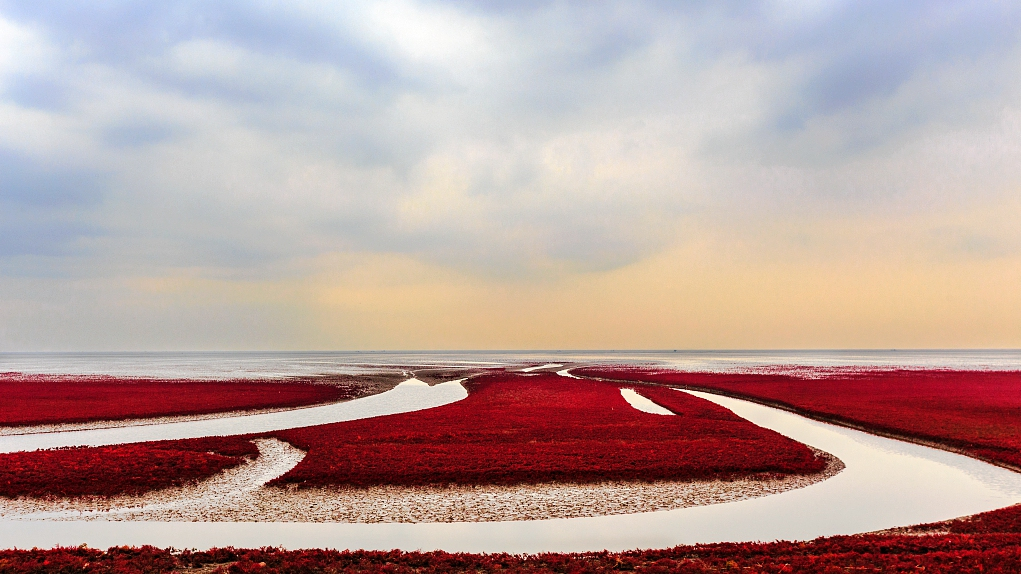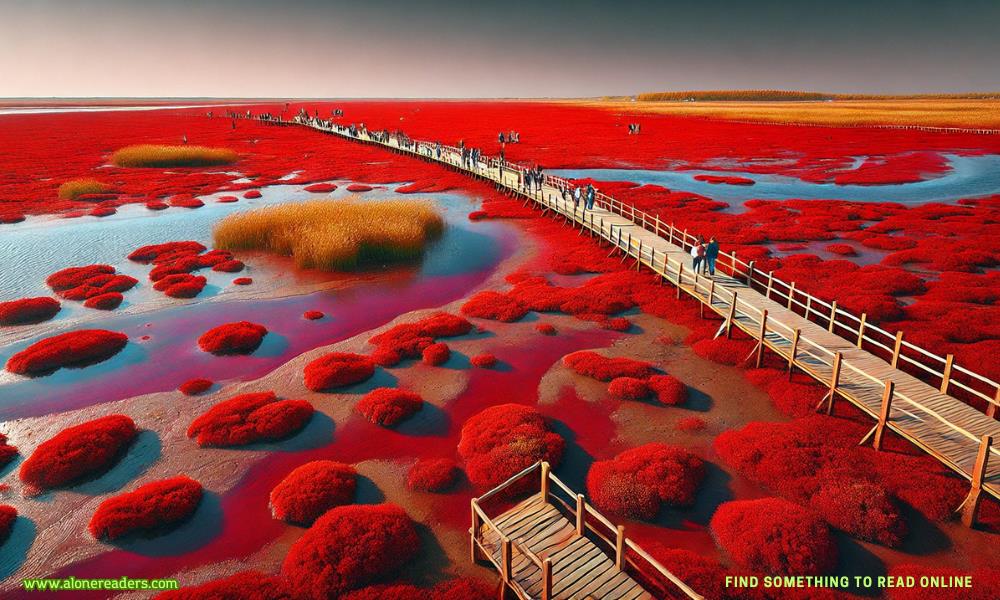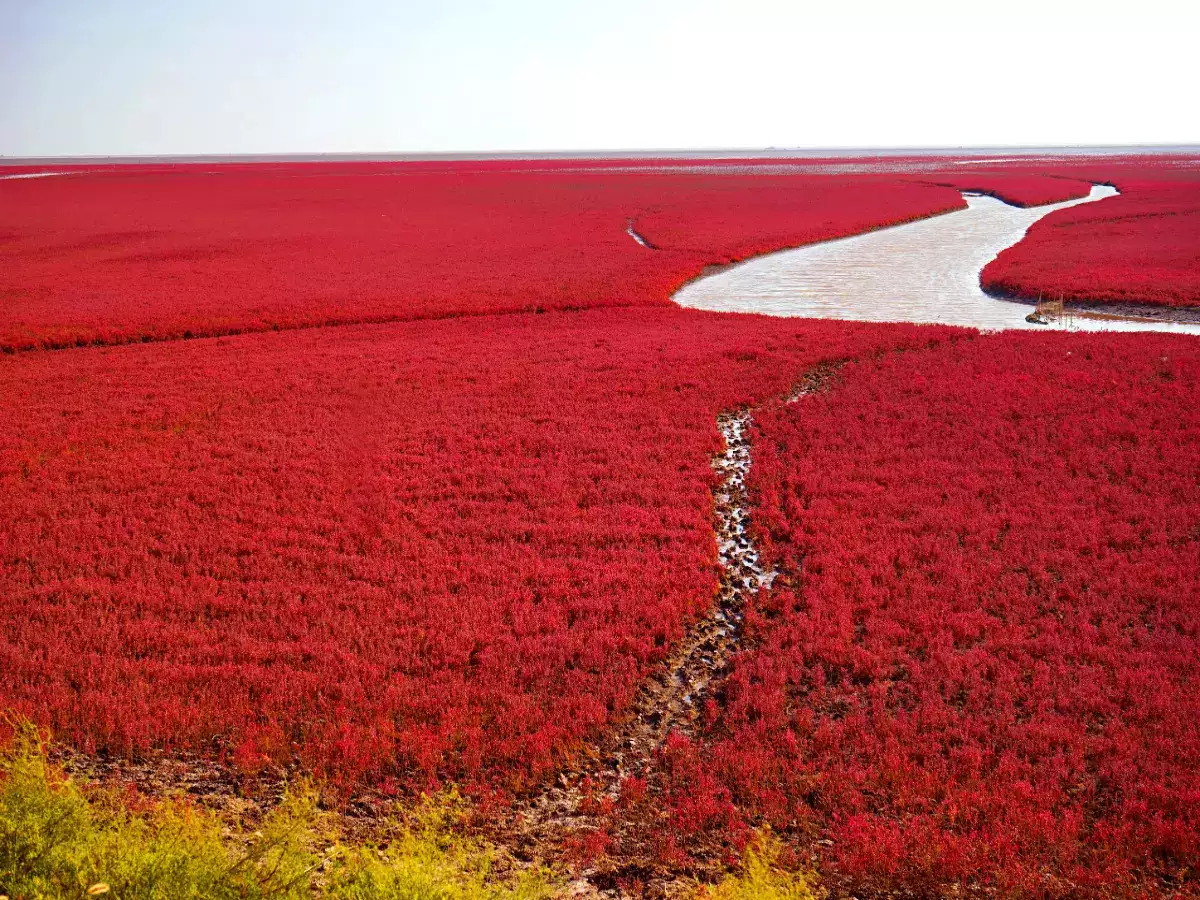Let’s get one thing straight. When someone says “beach,” your brain probably serves you up a blue ocean, white sand, a coconut with a tiny umbrella, and maybe a lifeguard running in slow motion. Classic, right? But what if I told you there’s a beach in China that flips that script? No, seriously. Say hello to Red Beach in Panjin — the surreal coastal wonder featured in every bold Red Beach China travel guide. Here, the sand is nowhere to be seen, and instead of blue waves, you get a vast sea of vibrant crimson. It’s like nature got hold of Photoshop and cranked up the saturation slider. Hard.
Welcome to the Red Beach, where the ground bleeds beauty — thanks to Sueda salsa, the red plant that turns this marshland into a glowing masterpiece.
What Is Red Beach, Anyway?

Despite the name, Red Beach isn’t your typical sandy paradise. It’s a massive wetland in the Liaoning Province of northeast China, located near the city of Panjin. Instead of sand, it’s covered by a unique type of red seaweed called Sueda salsa. This seaweed starts growing during April or May and turns a brilliant red color by autumn, turning the whole landscape into what looks like a flaming red carpet laid out just for your camera.
No, it’s not a filter. Yes, it’s totally real. And yes, your Instagram is begging for it.
Why Is It, Though? Nature’s Got Layers

The secret sauce to this crimson wonderland is Sueda salsa, a halophyte (fancy word for salt-loving plant) that thrives in saline-alkali soil. It starts green, just like your average plant, and then as the weather cools, it transitions into this dramatic red, almost burgundy shade. Think of it as the drama queen of the plant world.
The Red Beach is the largest wetland and reed marsh in the world, part of the Liaohe River Delta. Aside from being insanely photogenic, it’s also an important ecological zone that supports over 260 species of birds, including the endangered red-crowned crane and the black-mouth gull.
So yeah, it’s not just a pretty face—it’s also an ecological VIP lounge.
When’s the Best Time to Visit? (Because Timing Is Everything)

If you show up in spring, don’t blame the beach if it’s not red yet. The full-on crimson explosion happens between mid-September to early October, when the Sueda salsa is in its most dramatic phase. That’s your golden window for photos, romance, and pretending you’re in a Studio Ghibli movie.
Also, dress warm. Northeast China isn’t exactly tropical.
Can You Walk on It? Well… Sort of
Since Red Beach Panjin, China, is part of a protected nature reserve, you can’t just stomp around wherever you please. But there are wooden walkways and observation decks that let you explore without disturbing the environment. It’s like tiptoeing across a ruby-colored cloud — one made entirely by the incredible Sueda salsa red plant beach phenomenon.
And if you’re wondering about accessibility, yes, the walkways are safe, maintained, and wide enough for that dramatic slow-motion walk while someone films you.
How to Get There (No Teleportation Required)
Red Beach is located around 30 km southwest of Panjin City. Here’s the typical route:
- Fly into major cities like Beijing or Shenyang.
- From there, take a high-speed train to Panjin Railway Station.
- Then grab a taxi or local transport to Red Beach Scenic Area.
Or, if you’re feeling extra, hire a private car. You’ll feel like a VIP—just don’t expect paparazzi.
Estimated Costs for Visiting Red Beach, Panjin
Although Red Beach Panjin, China, isn’t as expensive as some other popular tourist destinations, there are a few costs to consider when planning your visit. Here’s an estimated breakdown of the expenses:
| Item | Estimated Price |
|---|---|
| Round-trip Flight | $300 – $650 (depending on the season and departure location) |
| Red Beach Entrance Fee | Free (since Red Beach is part of a nature reserve, but specialized tours may have fees) |
| Accommodation | $30 – $70 per night (depending on hotel or lodging choice) |
| Food & Drinks | $5 – $15 per person per day (depending on where you eat) |
| Local Transportation | $7 – $20 per day (for taxis or rented transport) |
Tip: Don’t forget to wear comfortable clothing and good shoes, as even though you can’t walk freely on the beach, you can still enjoy the views from the provided walkways.
Red Beach Travel Tips: Because We Care
- Go early in the day for fewer crowds and better lighting.
- Bring a good camera or at least a phone that doesn’t treat color like an afterthought.
- Layer up! The marsh breeze is no joke.
- Snacks & water, because red beauty doesn’t feed you.
- Binoculars if you’re into birdwatching. Some of these birds are practically supermodels.
Is It Worth It?
Let’s put it this way—if you’re bored of the usual palm trees and turquoise waters, Red Beach is a total game-changer. It’s a place where nature breaks the rules and somehow still makes it work. Whether you’re a traveler, a photographer, or someone who just wants a killer wallpaper for their phone, Red Beach delivers the drama, the beauty, and the bragging rights.
Plus, how many people can say they visited a beach that’s not even a beach, yet still stole the show?
Final Thoughts: Red Means Go (Travel)

In a world full of picture-perfect beaches, Red Beach dares to be different—and it wins. It’s a reminder that not everything beautiful fits the mold. So if you ever find yourself craving adventure, jaw-dropping views, and a beach that looks like it was designed by an abstract artist, pack your bags and head to Panjin.
Because at Red Beach, red doesn’t mean stop. It means: go take that perfect photo.
FAQ – Red Beach Panjin, China
1. Is Red Beach in China a beach?
Not really. It’s technically a wetland, not a sandy beach. But it’s called “Red Beach” because of the sea of red Sueda salsa plants that cover the area.
2. Why is Red Beach red?
The bright red color comes from a special plant called Sueda salsa that thrives in salty soil. It turns red in autumn, creating a surreal crimson landscape.
3. When is the best time to visit Red Beach?
The peak red season is from mid-September to early October. That’s when the colors are most vibrant and photo-worthy.
4. Can I walk on Red Beach?
You can’t walk directly on the red plants, but there are wooden walkways and viewing platforms for safe and eco-friendly exploring.
5. Where is Red Beach located?
It’s in Panjin, Liaoning Province, northeast China. Around 30 km southwest of Panjin city center.
6. How do I get to Red Beach from Beijing or Shanghai?
-
From Beijing: Take a high-speed train to Panjin (about 4 hours), then a taxi to Red Beach.
-
From Shanghai: Fly to Shenyang, then continue by train or car to Panjin.
7. Is Red Beach open all year round?
Yes, but the red color is only visible in autumn. Other seasons may still be peaceful, but not as visually striking.
8. Is Red Beach family-friendly?
Totally. The walkways are safe, the scenery is gentle, and birdwatching can be fun for kids, too!
9. Can I take good photos with just a smartphone?
Absolutely! Even with a decent phone camera, the red tones pop. Just make sure to go during golden hour if you want that pro-level glow.
10. Are there other attractions near Red Beach?
Yes! Check out reed marshes, crane-watching areas, and traditional fishing villages nearby for a full-day adventure.
Related Adventure: Mendenhall Ice Caves, Alaska
If surreal landscapes are your thing (and judging by your curiosity about Red Beach, they probably are), then don’t miss our article about the Mendenhall Ice Caves in Alaska. It’s a glowing blue world beneath a glacier — the Elsa-approved version of nature’s magic.
